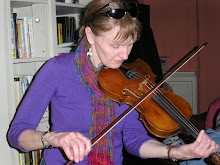We stopped at the Culloden Battlefield Visitor Centre. This famous battles lasted just 45 minutes and was the end of the Jacobite uprising. The visitor center overlooks a flat field where on April 16, 1746, the Duke of Cumberland sent Bonnie Prince Charlie fleeing. Not only were the Jacobite forces massacred that day, after the battle, Cumberland, know as "The Butcher" ordered all Jacobite supporters in the Highlands hunted down and slaughtered after the battle. http://www.nts.org.uk/Culloden/Home/
For a musical interpretation, listen to the McKassons "Culloden" on their recording "Tripping Maggie" http://www.themckassons.com/recordings.htm
Clava Cairns lies several miles from Culloden but receives just a fraction of the visitors. 
 and some standing stones, trees, and a few interpretive signs. As the group strolled through the site, which isn't much larger than a football field, I think the atmosphere seeped into our beings and most talking ceased. How can we ponder something so old when we live in a time when a car is old after 3 years, a dress is out of fashion after one year, and buildings that are 80 years old are torn down to make way for modern structures?
and some standing stones, trees, and a few interpretive signs. As the group strolled through the site, which isn't much larger than a football field, I think the atmosphere seeped into our beings and most talking ceased. How can we ponder something so old when we live in a time when a car is old after 3 years, a dress is out of fashion after one year, and buildings that are 80 years old are torn down to make way for modern structures? 
As we headed to lunch, we drove along the Moray Firth. You are more likley to see dolphins in these waters, more than any other place in Europe. We lunched at The Storehouse at Foulis Ferry on Cromarty Firth. The storehouse is a "girnal" meaning "grain store." Girnals are unusual in the Highlands. They were built as close as possible to water transport in the 18th and 19th centuries, before there were railways in the area. This efficient eatery offers tasty food and excellent service. I can highly recommend the roast beef Yorkshire pudding.
From there the A9 winds north along the North Sea. Numerous oil rigs are visible off shore.  Along the way, just a few miles off the main road along the River Brora
Along the way, just a few miles off the main road along the River Brora

Joan's husband, Steven Clark, is a bladesmith and musician. He apprenticed with a knifemaker and picked up the skill quite quickly. He likes giving old steel new life as a knife and believes knives should be functional, not just decorative. He likes using a variety of materials for th
Our final destination on the mainland was the ferry at Gills Bay. http://www.pentlandferries.co.uk/ This is the shortest ferry crossing to Orkney at this time of year, just one hour. Prepared with motion sickness drugs and pressure point bracelets, the travelers boarded the new Pentalina ferry for a pretty calm crossing. Some of the group found the best way to sail to St. Margaret’s Hope is with the wind in your face on the open deck.
St. Margaret’s Hope is on the island of South Ronaldsay. A quiet, sleepy little town, it is a great place to spend the first night on Orkney. Many visitors to Scotland don’t travel to Orkney, and even many mainlanders have never been here. I discovered the barren, enchanting pull of these islands on my first trip to Scotland. Orkney and the Shetland Islands lie between mainland Scotland and Norway. The islands once belonged to Denmark, and the Nordic influence in the place names (St. Ola, Stenness, Brodgar) is especially strong. Orcadians pride themselves in their heritage and not being mainlanders. Of 65 islands in Orkney, 17 are inhabited with a total of 20,000 residents. However, more and more folks are discovering this magical place. This summer over 60 cruise ships will dock in Kirkwall. One more reason I like to tour off-peak.




































